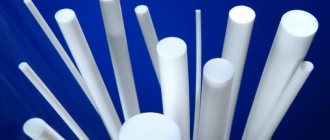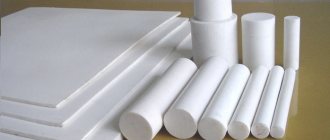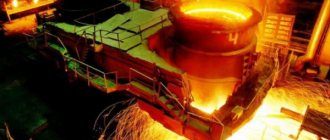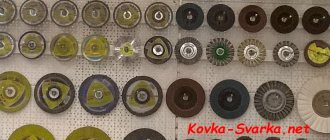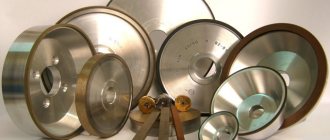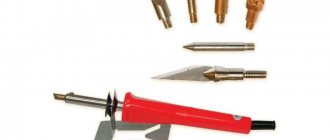Industrial development is impossible without improving the technological process and obtaining completely new, complex materials that combine the positive characteristics of simpler substances. As a rule, this requires studying and mastering new technologies for the synthesis of substances at the molecular level. A striking example is provided by two technically advanced types of polymers: fluoroplastic and caprolon.
To better understand the advantages of both materials, it is worth analyzing the characteristics and comparing caprolon and fluoroplastic with each other. This information will help you make the right choice of polymer to perform specific tasks.
Fluoroplastic and its properties
The material is a thermoplastic polymer, it is obtained from fluorinated olefins. Due to the high content of fluorine atoms, fluoroplastic is able to withstand the effects of many chemical compounds of an organic and inorganic nature. The material has a lot of advantages that have helped it become so popular.
- It has found application in medicine due to its compatibility with living tissues and biological harmlessness.
- Fluoroplastic is unique for its low coefficient of friction; this quality is in great demand in the production of various components that are subject to friction during operation.
- It is not afraid of radiation, corrosion, is slightly gas permeable, and is highly hydrophobic.
- It has high dielectric properties and electrical strength, and is highly wear-resistant.
- It tolerates temperature fluctuations, so the material can be used from -260 to +260 o C, it begins to heat up only after +300 o.
- It is classified as a cold-flowing material; it is not subject to combustion, and when ignited, it immediately extinguishes.
- Not afraid of aggressive environments, including chemical acids and solvents.
- It is remarkably amenable to machining, so the material can be sharpened, milled, ground, drilled, etc.
Such properties of fluoroplastic allow it to compete with metals , and in some respects even surpass certain types. It is considered a very promising material; it continues to be studied and researched in laboratories and institutes.
PTFE grades
Fluoroplastic -4 is one of the most common types of material, since it is characterized by excellent mechanical and electrical properties at a temperature range of -190+250 o C. Fillers that can be in fluoroplastic only improve many characteristics, so it is widely used in such industries as instrument making, mechanical engineering, food, medical, chemical, light, electrical and other industries.
Fluoroplastic 3 is less resistant to chemical reactions and thermal influences. The advantages include high strength and hardness, as well as the ability to melt and melt, which makes it possible to give the desired shape to the material. At low temperatures it continues to retain its mechanical properties.
Fluoroplastic 40 is characterized by high impact resistance and resistance to chemical attack, does not transmit UV rays, and is not afraid of radiation.
Fluoroplastic 4-F K20 is a very versatile material and has an increased degree of wear resistance. Recommended for the manufacture of movable joints, sealing and antifriction products.
Fluoroplastic F-4K15M5 - has a very low coefficient of friction, therefore it is suitable for working in friction units in conditions with wet gases and condensate. It has a very high degree of wear resistance.
Fluoroplastic 4-D is characterized by high dielectric properties; it is used for the production of hoses, thin-walled pipes, tapes, cable insulation, rods and other products by extrusion. Operating temperature range from -60 to +260 o C.
Advantages of fluoroplastic
Fluoroplastic is a thermoplastic made from fluorine derivatives of ethylene with a high fluorine content. It is fluorine that gives the polymer unique resistance to aggressive organic and inorganic compounds, extreme temperatures and pressures. The main advantages of the material:
- Chemical inertness (including to acids and solvents).
- Completely harmless and compatible with body tissues, which allows its use in medicine (in the production of equipment, instruments, prostheses).
- Low coefficient of friction, due to which fluoroplastic produces durable moving joint units that do not require additional lubrication.
- Hydrophobicity, low gas permeability.
- High electrical strength, dielectric properties, resistance to radiation.
- Mechanical strength, wear resistance.
- Exceptional heat resistance, low thermal conductivity (for the material to start heating, the environment must be heated to +300 °C).
- Non-flammable, self-extinguishing.
- Easily processed mechanically (grinding, cutting, drilling, milling), including manually.
Caprolon and its characteristics
Caprolon is an artificially created material, it is also known as polyamide 6 , its production was mastered about 30 years ago. Over all this time, it has been improved, so its technical characteristics have become better; parts made of caprolon can last longer than those made of bronze or steel. It is produced in the form of a sheet with a thickness of 6-200 mm, a rod with a diameter of 10-250 mm, and also round timber.
The performance characteristics of caprolon allow it to be used in various fields. It has found application instead of steel and bronze; parts are made from it for mechanical engineering, chemical, energy, oil and food industries and other areas of production. The material is ideal for the manufacture of parts of friction units, rollers and blocks and other mechanisms that have high wear resistance requirements.
The distinctive characteristics of caprolon are:
- High strength parameters;
- Good resistance to various chemical compounds;
- Absolutely non-toxic, therefore it is used for the manufacture of food equipment;
- Low coefficient of friction;
- Easy to process;
- Low thermal conductivity;
- It costs much less than metal.
Also worth mentioning as the advantages of caprolon is its low weight and resistance to corrosion. It withstands temperature changes and retains all its technical characteristics up to +140 o C.
Caprolon products are made in two ways - free casting or centrifugal casting .
Delivery forms
Most often, sheet caprolon is produced in the form of blanks for the production of numerous parts, including:
The material is mainly supplied in the form of sheets of various widths. The thickness can vary from 6 to 250 mm when these indicators change. It is recommended to select storage spaces with a low level of humidity.
Caprolon should be used with some caution due to its smoothness, elasticity and tendency to slip. When striking with a hammer or sledgehammer, specialists, observing increased safety precautions, first secure it on a flat surface. To avoid injury from sharp edges, wear protective gloves.
Which one is better?
There is much in common between caprolon and fluoroplastic, for example, they are both harmless and can be used in the medical and food industries. It is difficult to distinguish them by external signs; they are resistant to chemical elements.
Compared to fluoroplastic, caprolon is less wear-resistant, so it will last less, and also caprolon has a lower coefficient of friction , it is 0.2-0.3, and for fluoroplastic -0.2. To make bushings from caprolon, the part must be processed with an accuracy of hundredths of a millimeter. Fluoroplastic is a softer material; when pressed, marks in the form of small dents may remain. Caprolon is harder and makes a dull sound when struck.
Both materials have excellent characteristics, and which one is better will depend on where and for what purpose they are used.
Source: stanok.guru
Processing Features
Caprolon processing is possible on milling, turning, drilling and grinding machines. During turning work, it must be remembered that this material has a low melting level.
During long-term machining, it is recommended to use carbon steel tools and tungsten tips.
Caprolon sheets or bushings stored for a long time in the cold cannot be immediately processed on machines. They must be moved indoors for 5 days so that the temperature in the material becomes the same.
It is worth noting that parts made from caprolon have a service life 1.5 times longer compared to parts made from other materials. The cost of producing parts from such polyamide is significantly lower compared to metal parts. Caprolon from polyamide 6 allows the production of parts with low cost, high strength and low labor intensity.
Fluoroplastic and caprolon comparison
Synthetic polymer materials have long been used in many industries as a complete replacement for bulky and heavy steel parts, or to replace lower quality and resistant parts made from other materials. In addition to the best physical and technical characteristics, polymer materials have a significantly lower price, which is an important factor for many manufacturing enterprises and private consumers. There are quite a large number of different materials based on polymer compounds, for example, fluoroplastic, caprolon, textolite. Which one is better? The question is quite complex and ambiguous, so today we will compare caprolon and fluoroplastic - the two most popular and popular materials.
Types of engineering polymer
The polymerization process in the production of caprolon takes place using different technologies - certain activators and alkaline catalysts are introduced, so the result is six types of finished product with certain properties and purposes. Depending on the resulting structure of the material, the following types of products are distinguished:
- grade “A” – no pores are allowed on the cross-section of the sample. A high-density blank - caprolon - is used in the aircraft industry, where parts made from technological blanks are subjected to dynamic loads. The material has low weight, high strength;
- grade “B” assumes the presence of pores no larger than 1.5 mm. Spare parts for industrial equipment, machinery, vehicles, machine tools are cut from rods and sheets of this brand;
- The MG brand includes graphite in the antifriction composition - a modification of the blanks is produced in black. Parts made from the “MG” material are more expensive, but are superior in strength to other brands of caprolon;
- “MDM” brand is modified with molybdenum disulfide to impart dielectric properties to the material. Parts made from ultra-strong dielectric are used at gas processing and gas production enterprises;
- caprolon-42 – the modified grade is filled with graphite;
- Kaprolon-4-15 - the composition is used for the production of blanks with a flowing static charge and, following the example of the Kaprolon-42 brand, is filled with graphite.
According to the production method, the following types are distinguished:
- injection molding;
- heat-resistant with a heating limit of up to 259 °C;
- food;
- with the addition of solid lubricant;
- with fiberglass;
- produced by an extrusion process;
- with introduced polyethylene.
Less expensive, but more reliable, production is by casting. We obtain durable, wear-resistant parts for the industrial automotive industry, machine tools, and equipment. Together with lubricant, polymer spare parts in industrial installations demonstrate the low coefficient of friction of caprolon, reduce noise, and increase service life. The most common forms of release, accepted by technical specifications, are blanks in the form of rods, blocks, sheets, which differ in overall dimensions and weight of one batch.
Caprolon or fluoroplastic, which is better?
You can compare caprolon and fluoroplastic based on their performance properties and technical characteristics. By and large, both these materials have many similar features. In particular, due to their biological harmlessness to human life, caprolon and fluoroplastic are used in pharmaceuticals and food production as prostheses, elements of technological equipment, components and molded blanks. To determine whether caprolon or fluoroplastic is better, you should first study each of these materials. Upon careful examination of the workpieces, you will notice that caprolon is harder than fluoroplastic, since small marks are formed on the latter upon impact. But caprolon already has the highest degree of resistance to shock loads.
Since many people very often use fluoroplastic or caprolon for bushings, it is worth mentioning that both materials are well processed on special machines, be it milling or drilling equipment. But manually grinding caprolon will be much more difficult than processing fluoroplastic parts. Before considering the main technical characteristics and determining which caprolon or fluoroplastic is better, it is first of all important to understand and take into account the characteristics of the environment of use and the purpose of a particular workpiece. Since both of these polymer materials have excellent properties, we will compare 6 main parameters by which you can compare caprolon and fluoroplastic and choose the most suitable material for your conditions.
Source: s-agroservis.ru
Varieties of caprolon: sheet material
The most popular variety of this material is sheet caprolon, which is a blank used to produce various parts, namely:
- bushings;
- liners;
- flanges;
- rings
The material usually has the shape of a square with a side of 1000 mm, while the thickness can vary from 6 to 250 mm. However, these parameters are subject to change. The material should be stored in rooms with low humidity. Caprolon, the technical characteristics and features of which are described in the article, should be used with extreme caution, due to its elasticity, smoothness and slipperiness. Therefore, craftsmen should follow safety precautions when there is a need to hit the surface with a sledgehammer or hammer. This should be done only after the sheet has been secured. Experts advise working with the material with gloves, as your hands can be damaged by sharp edges.
The processing of caprolon sheets is carried out on metalworking machines, but some recommendations should be taken into account. During mechanical processing, heat dissipation should be ensured; the material has a low melting point. If complex processing is required, then it should be taken into account that the material may become cracked, so it is recommended to divide the work into several stages.
WHAT IS BETTER: PTFE OR CAPROLON
For a long time, polymer materials have been widely used in various industries, medicine, pharmacology and for household purposes. Due to their good mechanical and electrical insulating properties, resistance to aggressive environments and durability, polymers have established themselves as universal materials. They successfully replace “traditional” structural materials (steel, bronze, etc.) and are used for the manufacture of electrical insulation, protective coatings, etc.
For domestic purposes, polymers are used as decorative and finishing materials and for various crafts.
However, despite the large assortment, many polymers have similar properties, so we often face the problem of choosing the material most suitable for specific purposes and tasks. As an example, consider the differences between fluoroplastic and caprolon (polyamide PA-6). These materials practically do not differ in appearance and technical characteristics, which complicates the choice of which is better: caprolon or fluoroplastic . To understand this issue, let’s compare these materials and determine their advantages and disadvantages.
Comparison with analogues
The number of durable polymers is growing. Very often, caprolon and fluoroplastic are compared based on different properties. Along with some similarity, the uniqueness of each individual is revealed. In terms of resistance to heat treatment, fluoroplastic takes a leading position due to its ability to withstand temperatures up to 200C, which cannot be noted in relation to caprolon, which melts at this temperature.
Fluoroplastic has a longer service life, but due to the affordable price, products made from caprolon are much more profitable for the consumer.
Kaprolon
(Polyamide-6 block, PA-6 block) is a structural polymer obtained in the process of low-temperature anionic polymerization of caprolactam, carried out directly in the mold in the presence of alkaline catalysts and activators. [1]
Available in sheets, rods, blocks or custom products.
It is used for the manufacture of parts by mechanical processing of blocks of large-sized thick-walled and small-scale non-standard products for structural and antifriction purposes.
Fluoroplastic-4: properties and scope
Fluoroplastic is produced by polymerization of fluorine-containing ethylene derivatives. As a result, a semi-finished powder product is obtained for the manufacture of various parts and integral structures. At the first stage of production, a melt is prepared from polymer powder with the addition of catalysts, hardeners and various additives. Then finished products are produced using the injection or extrusion method. The industry mainly produces fluoroplastic in the form of sheets, blocks and rods. This polymer lends itself well to any type of mechanical processing, which makes it possible to obtain not only simple-shaped products, but also complex three-dimensional structures.
The physicochemical properties of fluoroplastics depend on the number of fluorine atoms. However, all of them are characterized by:
- Resistance to aggressive environments, corrosion and radiation;
- Resistance to high temperatures;
- Wear resistance;
- Plasticity and fluidity;
- Durability;
- Electrical insulating properties;
- High strength;
- Good machinability.
Fluoroplast-4 is characterized by abrasion resistance, heat resistance and high electrical insulating properties, but has fluidity and low strength compared to other brands. Fluoroplastics are used in mechanical engineering, automotive, chemical, food and other industries. These polymers are used to make pistons, bearings, electrical insulating gaskets, structural elements of containers for chemical reagents and other products.
Brands and forms of release
The most popular brand of fluoroplastic is fluoroplastic-4. This is a universal material with the best dielectric and mechanical properties, as well as maximum temperature resistance. Additionally, its properties are improved by adding various fillers.
Less popular fluoroplastic-3. Its chemical and thermal stability is somewhat lower, but it is stronger and harder than fluoroplastic-4. Fluoroplast-3 can be melted to produce parts of the desired shape. It tolerates low temperatures well.
The following brands of fluoroplastic are less commonly used:
- Fluoroplastic-40 (increased impact resistance and chemical resistance).
- Fluoroplastic 4-D (increased dielectric properties, heat resistance).
- Fluoroplastic F-4K15M5 (low coefficient of friction, high wear resistance).
- Fluoroplastic 4-F K20 (increased wear resistance, ideal solution for the manufacture of elements of moving joints).
Caprolon is known as polyamide 6 (PA 6). It is also produced in modifications PA 6-MG and PA 6-MDM, which differ slightly in performance characteristics. The main differences of the PA 6-MG brand are a wider range of elongation coefficients, increased hardness, low impact strength and high thermal conductivity. PA 6-MDM is characterized by a reduced coefficient of linear thermal expansion.
Fluoroplastic and caprolon are obtained in the form of powder semi-finished products after polymerization of monomers. Next, the powder is melted, catalysts, hardeners and additives are added. The melt is used to produce blanks or finished products by extrusion or casting. Materials are produced in the form of sheets, rods, and blocks.
Caprolon: properties and scope
Caprolon or polyamide PA-6 refers to heat-resistant polymeric materials obtained from chemical compounds containing amide groups. Caprolon is produced by polymerization of the feedstock in the presence of catalysts, stabilizers and other additives. As a result, a pale yellow or white powder is obtained, from which a melt is then prepared for the manufacture of polymer products using the injection or extrusion method. Caprolon is produced in the form of sheets and rods of various diameters. This material lends itself quite well to machining, welding and gluing, which makes it possible to manufacture parts and finished products of various shapes from it.
Manufacturers and cost of polyamide 6 block
It can be sold by weight, as it is manufactured in the form of sheets, sleeves, rods, circles or blocks. Caprolon varies in diameter and thickness. The average price of 1 kg of caprolon is 300-400 rubles. But it is worth noting that the final cost of a finished product or blank made from this material can be much higher.
Well-known production companies that specialize in this material in the Russian Federation are:
- • PP MTR-Service,
- • LLC PromResurs,
- • LLC PKF YuHK,
- • LLC EnergoTehProm-NN,
- • LLC Continent,
- • APEX-PLUS LLC.
Caprolon or fluoroplastic – which is better in the end?
To compare caprolon and fluoroplastic and choose which is better, we will use a table that shows the main technical characteristics of these materials:
| Indicator name | Indicator value | |
| Ftoroplast-4 | Kaprolon PA-6 | |
| Color | from light yellow to white | white or yellowish |
| Release form | rods, sheets, blocks | rods, blocks |
| Density of material, kg/m3. | 2100 – 2200 | 1150 – 1160 |
| Operating temperature range, °C | –269 … +260 | – 30 … +110 |
| Thermal conductivity coefficient, W/m°C | 0,25 | 0,3 |
| Water absorption,% | 0,0 | 1,5 – 2 |
| Tensile strength, MPa | 20 – 30 | 80 – 90 |
| Ultimate compressive strength, MPa | 12 – 15 | 100 – 110 |
| Elongation at break, % | 350 | 600 |
| Brinell hardness, MPa | 30 – 40 | 160 – 180 |
| Electric strength, kV/mm | 50 | 30 – 35 |
| Dielectric constant at 1 MHz frequency | 0,002 | 3,3 |
| Dielectric loss tangent at a frequency of 1 MHz | 0,2 – 03 | — |
| Coefficient of sliding friction on steel in lubricant | 0,02 | 0,06 – 0,08 |
| Coefficient of sliding friction on steel without lubrication | 0,2 | 0,2 – 0,3 |
| Abrasion resistance | high | very high |
As can be seen from the table, caprolon or fluoroplastic have practically no differences in appearance , but in physical and mechanical properties they have quite significant differences. Therefore, when choosing a polymer, you should pay attention to the following criteria:
- Mechanical strength and hardness;
- Electrical insulating properties;
- Resistance to abrasion and wear;
- The magnitude of the sliding friction coefficient.
In terms of strength characteristics, caprolon is stronger than fluoroplastic , but is somewhat inferior to it in hardness and workability. Caprolon is more resistant to abrasion and wear and works better under long-term loads. The electrical insulating properties of the materials differ slightly.
It is also worth paying attention to the cost of materials. The price of caprolon is from 250 rubles. for 1 kg, and fluoroplastic - from 500 rubles. Thus, when comparing caprolon and fluoroplastic and choosing which material is better, we start from the following criteria: for working in difficult conditions and mechanisms with increased wear of parts, it is preferable to use caprolon, and in conditions of exposure to chemically aggressive environments and elevated temperatures, fluoroplastic performs better.
Source: msel.ru
Technical specifications
Despite the relative youth of the material and recent use (no more than 30 years), its scope of application is expanding, and its popularity is growing , largely due to its properties and characteristics.
Caprolon, technical characteristics:
Just a small part of the technical parameters shows the high strength and wear resistance of caprolon.
Which is better caprolon or fluoroplastic - an overview of the properties of caprolon and fluoroplastic
In the ElektroStal store you can buy both caprolon and fluoroplastic. Both materials are similar in appearance and our customers use them to make bushings, rollers and gears for various mechanisms. They often ask the question: which is better, caprolon or fluoroplastic?
This question is difficult to answer without taking into account the specific operating conditions of the parts and the properties of the materials themselves. To help answer this question, I will consider the main differences in the properties of caprolon and fluoroplastic, and you yourself decide in which case to use caprolon and in which to use fluoroplastic.
1. Friction coefficient. For fluoroplastic, the coefficient of friction on steel in the absence of lubrication is 0.04, and when it is used it is 0.02. Caprolon has a higher coefficient of friction than fluoroplastic and is equal to 0.1-0.2 and 0.06-0.08, respectively.
COEFFICIENT OF FRICTION is a quantitative characteristic of the force required to slide or move one material over the surface of another. The coefficient of static friction determines the force required to initiate motion; The coefficient of kinetic friction (friction of motion) determines the force required to maintain motion.
2. Operating temperature. The maximum temperature that does not lead to destruction of caprolon during prolonged exposure is 110C. For fluoroplastic, the maximum operating temperature is higher - up to 300C.
3. Resistance to deforming effects of compression and tension. For fluoroplastic, the compressive modulus of elasticity
700 MPa, and for caprolon
2100 MPa. Consequently, caprolon is more resistant to deforming influences.
The “modulus of elasticity” indicator characterizes the ability of a material to resist tension or compression. Essentially, it is the limiting stress in a material that will cause elastic deformation. Elastic deformation is deformation that disappears after the load on the material ceases. In this case, the part takes on its original size and shape.
4. Impact resistance. Impact resistance is characterized by the impact toughness of a material and represents the ultimate impact that does not lead to its destruction. For fluoroplastic, the maximum impact is
10 MPa, and for caprolon
5. Yield strength Yield strength is the stress in a material under the influence of loads at which plastic deformation begins to develop. Fluoroplastic has a yield strength of 11-14 MPa, and caprolon has a yield strength of 70-80 MPa.
Plastic deformation is a deformation that does not disappear after the load is removed: the dimensions of the part change by a certain amount of deformation.
6. Hygroscopicity. Hygroscopicity is the ability to absorb liquid. Caprolon has increased water absorption: it gains 1.5-2% of its mass in 24 hours. Often this property has a positive effect on the life of the bushing: the wear of its surface is compensated by expansion due to the absorption of liquid. For fluoroplastic, this indicator is almost equal to 0.
Table of properties of caprolon and fluoroplastic
| Kaprolon | Fluoroplastic | |
| 1. Friction coefficient | 0,1-0,2 / 0,06-0,08 | 0,04 / 0,02 |
| 2. Operating temperature | 110 | 300 |
| 3. Compressive resistance | 2100 MPa | 700 MPa |
| 4. Shock resistance | 14 MPa | 10 MPa |
| 5. Yield strength | 70-80 MPa | 11-14 MPa |
| 6. Hygroscopicity | 1,5-2% |
I hope that after reading the article, you will be able to answer the question of what is better than caprolon or fluoroplastic in your particular case.
Remember that under certain operating conditions, the lack of material can be used as an advantage. For example, at medium and high specific pressures, fluoroplastic begins to deform (change shape, size, flow). For bushings, this “disadvantage” can be used to its advantage. If you do not make the exact dimensions of the bushing, but make the outer diameter of the bushing slightly larger, and the inner diameter slightly smaller, and then press the bushing onto the shaft. In this case, the fluoroplastic is deformed and takes the desired shape and size. The bushing can be used perfectly, albeit without shock loads.
Good luck with your choice. Share your thoughts and experiences in the comments below.
Source: blog.electrostal.com.ua
Receipt
To obtain high-density caprolon, it is necessary to carry out a low-temperature polymerization reaction, in which aminocaproic acid, alkaline catalysts and activators will take part.
The resulting material can be diluted in phenolic and cresol solutions. This material is considered an excellent dielectric.
According to the state standard, this polyamide must be manufactured in accordance with the requirements of GOST 7850-86. “Caprolon. Technical conditions".



